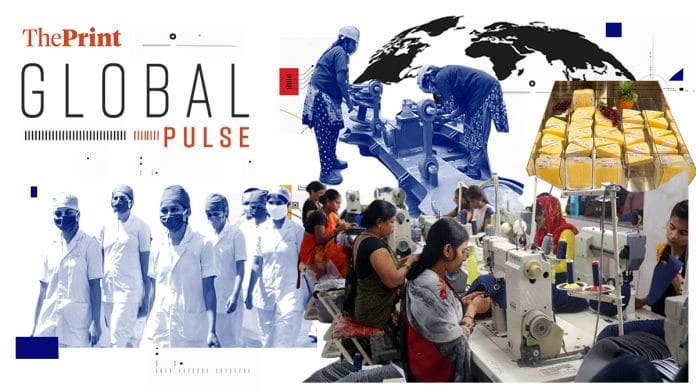New Delhi: The way to turbocharge growth in India is to encourage women to enter the paid workforce—and to keep them there safely, reports the Financial Times
In a detailed story on the need for including women in India’s economy — especially amid pervasive violence against women, including in the workplace as the recent Kolkata rape case demonstrates—the FT writes that if women’s participation reached 50 percent, then India could boost its annual growth rate by 1.5 percentage points.
Compared to close economic competitors like China and Vietnam and South Asian neighbours like Bangladesh, India’s female labour force participation rates are dismal. And part of the reason why is because women’s safety is such a big issue in India. Indian women feel less safe now than they did a few years ago, FT reports.
“Women do, of course, contribute enormous amounts to the Indian economy, but largely via unpaid work at home, in family businesses or in agriculture. Because of entrenched patriarchal and cultural norms, Indian women are heavily burdened by caregiving responsibilities, analysts say, limiting workforce supply. A recent government report estimated that childcare and home commitments kept 44.5 percent of women out of work,” the piece elaborates.
Pointing out regional differences—like how women’s participation in the workforce is higher in South India and across rural belts compared to the urban areas—the story also goes into the Modi government’s policies and benefits designed to support women. “Economists point out, however, that such policies incentivise women to stay at home, and that it might be more valuable for the state to create employment in areas where women are under-represented, including law enforcement,” it says.
The Economist has a slightly different take on India’s economy: in a deep dive on its clothes exports—which notably employs mostly women, especially in the textile belt of Tamil Nadu—the publication offers lessons on how manufacturing firms can grow.
Centering the story around the growth of India’s biggest clothes exporter, Shahi Exports, The Economist points out that three things hold India back: its labour laws, trade restrictions, and convincing workers to leave farms and join factories.
“What can be done? India’s government seems to understand the issues, but politics gets in the way,” the story laments.
While amended labour laws have been passed, the reforms don’t tackle the clothes export industry’s biggest concerns. Handouts from the government’s industrial-subsidy scheme are hard to get, and most clothes-makers don’t qualify because they split investments across several factories. Employment-linked incentives are also only a small step towards manufacturer’s problems with retaining a full-time workforce.
“It is time the government stitched together a much more ambitious plan,” The Economist declares.
Meanwhile, The Guardian takes a look at another ailing Indian sector: healthcare.
In a story on leprosy, The Guardian claims that experts are sceptical of India’s target to eliminate the disease by 2027. There are over 200,000 new leprosy cases reported each year, and 60 percent of them are in India.
The Indian government launched the Leprosy Mukt Bharat campaign in January 2023, which sets the target of eradicating the disease by 2027—three years ahead of the WHO’s target of 2030. But limited training, a shelved vaccination rollout and the lack of awareness campaigns stand out as massive hindrances to this plan.
The push to eliminate leprosy is “more grandstanding than genuine commitment, with undercounting of patients to meet targets, part of a larger trend of public health focused on politics rather than patients,” the Guardian writes.
This comes after India won a massive battle against the disease: In 2005, cases dropped from more than 4 million in 1982 to only 200,000. But, instead of strengthening the resolve to kill the disease once and for all, it “encouraged the Indian government to shutter leprosy-specific programmes”. And over the past two decades, leprosy diagnosis and treatment has also stopped being taught at medical schools—which means more people are being misdiagnosed, which has led to the disease spreading further and an increased risk of community infections.
“Given the WHO’s 2030 target, the government might be concentrating seven years’ worth of resources into a compressed time frame, making the case in 2027 when they fail, ‘the light at the end of the tunnel is visible; let’s allocate some more’,” the Guardian claims. The story ends with the admission that the Indian health ministry did not respond to their requests for a comment.
At the risk of sounding cheesy, it’s not all doom and gloom for Indian innovation—India is the next great frontier for cheese, the Wall Street Journal claims.
“Why has milk-obsessed India, with its sophisticated culture of milk fermentation and reduction, come so late to cheese?” the piece asks. Paneer is passe, western-style cheese is now the toast of town.
This globalised phenomenon—with more and more Indians developing Western palettes—fits extremely well into the Indian dairy landscape. India is the largest producer and consumer of dairy products in the world, worth about $26 billion and growing at 7 percent a year. The domestic market for cheese, specifically, is worth $1 billion and growing at a rate of 21 percent a year.
“The market for gourmet cheese in India is largely confined to four megapolises: Mumbai in the West, New Delhi in the north, and Bengaluru (formerly Bangalore) and Chennai in the south. But it is growing rapidly, spurred by young cheesemakers, many of whom developed their taste for fromage abroad,” the story, by writer and essayist Chandrahas Choudhary, says.
As more people discover traditional methods of catering to globalised tastes, indigenous dairy products like Kalari cheese of Kashmir and the Chhurpi of Sikkim are making a comeback. Colonial cheeses—leftover Portuguese and French recipes, particularly—are also being rediscovered. And cheese is also making its way into normal Indian foods, from dosas to parathas.
All in all, cheese seems to have entered the urban Indian market in a big way. Move over, paneer.
Also read: Global media has its eye on ‘fantastic’ Modi & Trump’s reunion in US & thawing India-China relations






